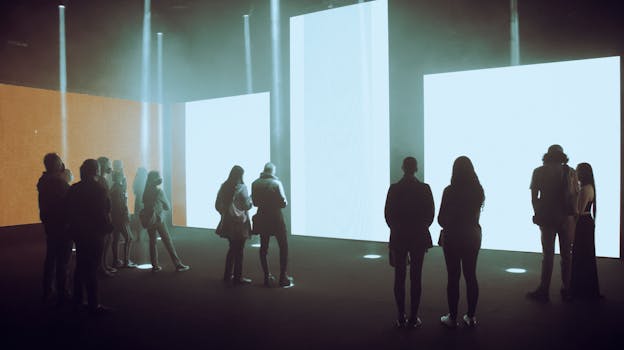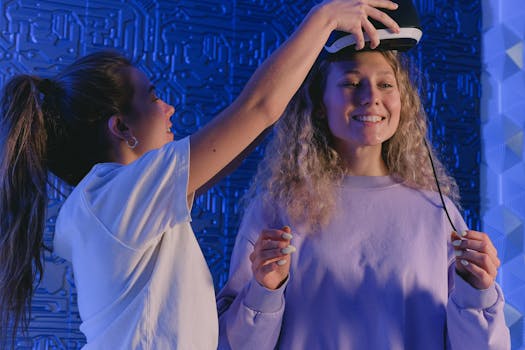Anúncios
Nothing draws people into a story quite like feeling present inside it. Audiences yearn for more than just watching—they crave genuine connection. When virtual reality storytelling enters the scene, the sense of ‘being there’ magnifies emotions in a way flat screens never could.
Emotional storytelling isn’t new, but immersive technology adds new depths. As creators experiment with virtual reality storytelling, they’re discovering techniques that evoke deeper empathy, awe, and self-reflection compared to traditional media. This shift means storytellers can guide users through richly emotional journeys with more agency than ever before.
By exploring this article, you’ll gain practical insight into why virtual reality storytelling creates stronger emotional resonance, and what specific methods make these experiences memorable. Let’s step inside the story—literally—and see how the medium changes everything.
Building Real Emotion in 360-Degree Experiences
Creating real emotional impact in virtual reality storytelling demands specific techniques that go beyond visuals. Designers script every detail: sound cues, tactile responses, and interactive objects work together to ground feelings in the user’s body.
This approach immerses the participant so deeply that even small actions—like touching a meaningful object or hearing a whispered secret behind them—create authentic reactions. Guided by strong design, emotional arcs feel more personal and real.
Visual Direction That Drives Empathy
Designers position story events within the entire 360-degree space. Instead of a single frame, “look here” cues—color, movement, or even a nudge—subtly direct the user’s attention, making them feel actively engaged.
Imagine glancing over your shoulder and seeing a character respond to your gaze in a virtual reality storytelling moment. This presence amplifies emotional resonance, as personal choices alter how close you feel to story outcomes.
Designing for empathy means blending subtle scene management with free exploration, so that users both follow the story and influence their own emotional journey. This flexibility sets VR apart from traditional formats.
Sound, Touch, and Layered Memory
Surround-sound audio and simple vibration cues help users anchor emotions physically in virtual reality storytelling. For example, soft footsteps approaching from behind raise anticipation or nervousness—users turn, heart beating faster because they anticipate real-world consequences.
Haptic feedback can reinforce emotional peaks: a hand resting on a virtual friend’s shoulder might evoke real warmth through a gentle controller pulse. These micro-interactions ground every emotional moment in memory.
After the experience, users often reference details using physical gestures—pointing, turning, or even shivering. These embodied responses prove that well-crafted VR stories truly leave lasting impressions.
| Technique | Traditional Media | VR Storytelling | Actionable Advice |
|---|---|---|---|
| Visual Focus | Fixed frame, edits control view | User controls gaze, 360° view | Create cues to gently direct attention to key moments |
| Sound | Stereo, on-screen source | Spatial, surrounds user | Use 3D audio to trigger anticipation and emotion naturally |
| Agency | Audience observes action | User participates, alters order | Let users influence timing or sequence for deeper immersion |
| Touch/Haptic | None or controller rumble | Integrated, matches dramatic moments | Add tactile cues to underscore emotional highlights |
| Memory | Visual, narrative recall | Bodily, spatial recall | Anchor key beats to gestures or surroundings users will remember |
Storyworlds: Creating Emotional Contexts That Feel Personal
Every effective virtual reality storytelling experience drops users into believable worlds, making their choices feel uniquely impactful. Storyworlds aren’t passive—they respond, adapt, and remember how users interact with them.
Designers set up rich emotional contexts—a family kitchen, an alien temple, a childhood bedroom—each crafted with relatable details. These worlds create a canvas for personal, emotionally driven narrative interaction.
Dynamic Characters and Responsive Dialogue
Virtual reality storytelling benefits from dynamic non-player characters that change their responses based on user behavior. “If I avoid eye contact, the parent’s tone grows harsher.” Body language, shifts in dialogue, or emotional cues respond in real time.
The script and delivery adapt to choices. If you comfort a character, they might show gratitude with softer expressions. Ignore them, and their disappointment becomes visible. Every interaction becomes an opportunity to deepen emotional investment.
- Include branching conversations so each response feels tailored. This keeps users engaged and makes emotional outcomes uncertain and personal.
- Script multiple emotional reactions for characters. Users notice small changes, like a slight smile or frown, which increase realism.
- Give characters realistic body language rooted in the story’s context so they feel alive, not robotic.
- Link character mood to the user’s choices, letting players sense if they’ve helped or hurt someone within the storyworld.
- Provide visual and audio cues when a character remembers past user actions, reinforcing the result of each choice.
These techniques help characters in virtual reality storytelling seem genuinely present—everyone you meet feels unpredictable, just like in real life, making emotional decisions matter.
Environmental Cues That Trigger Emotional Recall
Every virtual reality storytelling environment holds objects, sounds, and lighting that echo users’ past experiences, triggering powerful emotional responses. For example, entering a softly lit kitchen may remind a user of family gatherings, making scenes feel deeply personal.
- Arrange familiar objects with unique details—photos, notes, keepsakes—that evoke biographies and prompt users to draw from memory.
- Use environmental audio (like distant laughter) to create nostalgia or melancholy, shaping how users approach the next story beat.
- Set lighting to influence mood: warm, inviting for tenderness, or harsh and shadowy for tension. Tone changes signal shifts in the emotional arc.
- Add subtle scent cues when possible—like digital baking smells—to deepen immersion, linking emotions to senses beyond sight.
- Shift atmosphere dynamically if the user lingers or interacts, signaling that their attention is shaping the world’s emotional texture.
With purposeful world-building, designers turn every scene in virtual reality storytelling into a reflection of personal, lived memory—enhancing the user’s sense of ownership and emotional truth.
Decision Points Give Players Agency Over Emotions
When storytellers intentionally add branches and choices, virtual reality storytelling invites participants to guide their emotional journey. The power to pick a path, help or hinder, or even just pause and reflect, gives users a sense of agency missing in passive stories.
Players recall lines like, “I chose to forgive her, and it changed everything,” or, “When I ran away, the ending felt hollow.” This power amplifies every feeling.
Making Choices That Change Outcomes
Interactive VR experiences offer branching narratives where emotional stakes are clear: “If you comfort your friend, she might heal. Ignore her and she suffers.” Each decision shapes later scenes and the emotional tone of the story’s climax, sometimes dramatically.
Creators integrate visual signposts or gentle reminders that hint at consequence, increasing anticipation: “Are you sure you want to say that?” The result is a living narrative users feel responsible for—every outcome reflects a personal choice.
Personal agency encourages replay: users experiment with decisions, chasing feelings they missed or regret, deepening attachment each time they return to the storyworld.
Branching Paths That Reinforce Emotional Learning
Branching paths aren’t just narrative tricks—they offer real-time emotional learning. Users immediately see the impact of kindness, avoidance, or anger, then reflect on their choices. Later, emotional growth feels authentic, not forced.
Some VR creators include gentle feedback loops, where repeated choices unlock new avenues or resolve old regrets: “You apologized, so now she opens up,” or, “Ignore her twice and the distance never closes.”
Unexpected results—joy after risk, regret after indifference—help users link virtual actions with real feelings. These moments become mental models for real-world relationships, making emotional lessons stick.
Crafting Empathy Through Perspective-Taking and Embodiment
Perspective-taking is the heart of empathy. Virtual reality storytelling lets users literally see through another’s eyes, sensing what life feels like from a body not their own. Embodiment amplifies this effect.
“When I looked down and saw someone else’s hands, I was startled—it wasn’t just acting, I felt changed,” one user reported after a VR empathy experience. These shifts make emotions immediate and personal.
Swapping Points of View Without Losing Connection
Some VR designs allow users to “step into” another’s shoes with a button press or when prompted by emotional cues. Suddenly, you’re no longer yourself—you embody the parent, the child, or even the story’s antagonist.
This swap isn’t temporary role-play. For a few crucial moments, all sensory input matches the new character: the heaviness of guilt in a father’s stance, the anxious fidget in a teen’s hand gesture. Users process feelings not just intellectually, but physically.
Creators choreograph transitions—mirrored gestures, changing perspective height, shifts in internal monologue—so users adapt quickly while remaining emotionally grounded. Users internalize nuanced reactions: “That’s why she felt scared. I felt it too.”
Embodied Interactions That Build Sympathy
Virtual reality storytelling often builds scenarios around physical tasks: cradling an injured friend, guiding a trembling hand, or catching your own reflection in a virtual mirror. These moments foster tangible empathy, not just narrative understanding.
Tasks reward users for empathetic action. For instance, gently wiping away tears unlocks trust, while rough gestures increase distance. “The controller vibrated when I squeezed too hard, so I learned to be careful.” Embodiment links emotions with real consequences.
Behavioral cues—slumped posture, heavy footsteps—invite users to mirror emotions. The more closely you match the avatar’s state, the richer the sympathy you build, making every moment feel transformative.
Directing Attention and Emotional Pacing Inside VR Storytelling
Effective use of attention management and pacing makes virtual reality storytelling feel cinematic, yet deeply personal. Creators control not just what users see, but when and how emotions unfold—delivering powerful, memorable arcs.
By controlling transitions, scene speed, or timed surprise reveals, storytellers intensify anticipation, joy, sadness, or catharsis exactly when desired, mirroring the beats of a masterfully told story in any medium.
Guiding Focus with Immersive Design Cues
Since users can explore freely, designers use sound cues, moving objects, or lighting to draw attention at key moments. For example, a sudden flicker or a meaningful whisper might pull the user’s gaze to a critical scene.
These signposts are crucial when emotional shifts approach. Timed cues prompt users to turn, pause, or engage—their curiosity working hand in hand with emotional resonance, ensuring core moments aren’t missed.
Organic integration of hints maintains immersion: nobody feels forced, yet everyone shares the same big emotional payoffs, regardless of where they look or go within the storyworld.
Scripting Emotional Highs and Lows in Sequence
Crafting the perfect sequence of emotional events requires real-time user tracking. Straightforward progressions—frustration, followed by relief, and then awe—can be heightened with simple tweaks like pausing for breath before climactic reveals.
Designers monitor where users linger. “If they pause at her photograph, let the music swell.” Sudden changes—music cuts, curtain drops—signal story transitions, prepping users for new emotional beats or reactions.
Pacing isn’t uniform; designers unleash variety. Fast action scenes drain adrenaline, while quiet reflection amplifies regret or nostalgia. This rhythm shapes the overall emotional signature of the VR story.
Learning and Healing: Positive Outcomes in VR Emotional Storytelling
Virtual reality storytelling is being embraced for emotional growth, education, and therapeutic healing. Carefully crafted VR stories let users step through scenarios they’d otherwise avoid, safely experiencing difficult emotions with support and guidance.
From anxiety exposure to trauma recovery, VR places users in controlled, scalable environments where they can face fears, practice coping skills, or rehearse empathy in repeatable, nonjudgmental situations.
Real-World Applications: Therapy and Wellbeing
Clinicians guide patients through custom VR journeys, like confronting social anxiety or learning to regulate anger. Virtual reality storytelling gives users a blueprint: “Practice deep breaths when you feel your heart race—notice how people react differently.”
Therapeutic VR stories often include pause-and-reflect mechanics, journaling prompts, or supportive chatbot guides. “When I faced my fear virtually, I built courage and picked up skills I now use daily,” reported one user after VR therapy sessions.
Success stems from repeatability and control: users try as many times as needed, watching their emotional resilience and coping strategies strengthen over time, with the safety of adjustable, clearly defined boundaries.
Role-Play for Empathy-Building in Education
In classrooms, educators use virtual reality storytelling to teach empathy by assigning roles with conflicting perspectives on an issue. “You’re the newcomer, you’re the local resident—live through their eyes and act accordingly.”
Guided discussion follows each VR session, turning virtual emotions into meaningful dialogue: “How did it feel to be left out? What did you notice about your reactions and the choices you made?”
By transferring learning from VR role-play to real-social settings, students broaden emotional insight and grow as compassionate, collaborative communicators, ready for a diverse world.
Evolving Tools and New Frontiers in Virtual Reality Storytelling
The future of virtual reality storytelling brings lighter hardware, more intuitive interfaces, and photorealistic worlds. These advances put ever more nuanced emotional storytelling tools into the hands of creators everywhere.
Professionals now explore cross-platform stories, haptic suits, and AI-driven adaptive scripts to further individualize each journey—each step focused on deeper, more personal emotional resonance.
No-Code Creation and Community-Driven Content
With user-friendly software, anyone can now prototype a virtual reality storytelling scene in hours. “I created a personal loss story—strangers shared, cried, and helped adapt it for new viewers.” Community-driven hubs allow iterative improvements based on feedback.
New markets for storytellers emerge, offering ready-made emotional story templates, plugin toolkits for haptics, mood analysis, or branching dialogue. This democratization fuels growth in personal, authentic emotional VR stories.
When everyone becomes a creator, communities develop best practices—like safe zones for emotionally intense content or shared calibration for haptic effects—ensuring safety and consistency as VR storytelling enters mainstream culture.
Personalized Stories With Adaptive and Reactive AI
Creators train AI to read user voice, heart rate, or gaze, adapting the story’s pace, outcome, or music in real time. For example, “If a user sighs or fidgets, slow the story, adjust dialogue, or cue a gentle score.”
Reactive AI means everyone’s virtual reality storytelling journey becomes unique, even when using the same underlying world. The experience feels like a living, breathing story, responsive to even small emotional signals.
This evolutionary leap brings emotional storytelling closer to true personalization, allowing users to feel fully seen, understood, and moved, regardless of their starting point or skill level.
Active Engagement: The Journey Toward Emotionally Meaningful VR Stories
Virtual reality storytelling has redefined how we connect with stories—making every experience more visceral and memorable for users. Designers, therapists, and educators now collaborate to create powerful narratives that foster genuine growth and connection.
Each step forward unlocks new creative directions, with deeper empathy and personalized experiences available to everyone who enters a VR world. As new tools emerge, the boundaries of emotional storytelling keep expanding.
The future holds fresh opportunities to craft and share stories that resonate beyond the virtual realm, shaping real-life empathy, action, and self-understanding. Embrace these possibilities to make your next story truly unforgettable—for you and your audience alike.



